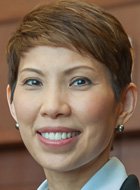 Laura Liu
Laura Liu
A state appeals panel has cleared the way for a partner in a business to be sued over a $3 million judgment, even though the partner was found not individually liable in the underlying suit.
The 1st District Appellate Court looked to three outside jurisdictions in a 16-page opinion written by Justice Laura Liu.
“Surprisingly, there appear to be no Illinois decisions that directly address the present issue, i.e., whether a judgment creditor of a partnership may sue an individual partner to enforce the partnership’s obligation when the partner was named in the underlying action and found not liable,” Liu wrote.
The plaintiff in the case, William T. Andrews, was injured in a car accident in February 2007 by an employee of G&G Cement Contractors, a partnership owned by brothers Jose and Dagoberto Gonzalez. Andrews sued G&G, the driver of the company car and both Gonzalez brothers in Cook County Circuit Court in case No. 07 L 7742.
Jose Gonzalez died while the case was pending, and his estate was substituted as a defendant.
Following a January 2013 trial before Associate Judge Michael R. Panter, a jury found G&G and the car’s driver were at fault, but found in favor of the two brothers individually. It awarded $3,092,000 in damages.
G&G held a $300,000 policy with Century National Insurance Co., but the insurer would only pay the policy limit if Andrews agreed to execute a release for the rest of the judgment amount.
Instead, Andrews filed citations to discover assets against Dagoberto Gonzalez and the insurance company.
In April 2013, Circuit Judge Alexander P. White ordered Century National to pay the $300,000 policy limit plus interest. The next month, the court ordered Gonzalez to assign rights against Century National to Andrews.
Andrews filed a new complaint in Cook County Circuit Court in July 2013, seeking to recover the remaining amount of the $3 million judgment from Gonzalez’s personal assets.
The complaint also alleged Century National showed bad faith in refusing to pay the policy limit.
Gonzalez moved to dismiss the case, asserting it was barred by the doctrine of res judicata — arguing that Andrews unsuccessfully sought to enforce the judgment in supplementary proceedings in the underlying case.
But Andrews contended the Code of Civil Procedure provides an exception to res judicata, allowing a separate action to enforce a partner’s individual liability for obligations of his partnership.
Circuit Judge Kathy M. Flanagan dismissed the case in January, agreeing with Gonzalez that Andrews’ claims were barred.
On appeal, Liu wrote that, generally, partners are jointly and severally liable for any of a partnership’s obligations, and recovery from a partner’s assets is available when there is also judgment against that partner.
“The question presented here is what recourse is available when a plaintiff cannot satisfy a judgment against a partnership,” Liu wrote.
Without precedent from Illinois courts, Andrews presented the panel with similar rulings from Indiana and Ohio state courts and the New Orleans-based 5th U.S. Circuit Court of Appeals.
“The case at bar is similar to the preceding cases in that the plaintiff is seeking to collect an outstanding judgment against a partnership from an individual partner despite the fact that the individual partner was named in the underlying lawsuit,” Liu wrote. “It is further similar in that the individual partner, Dagoberto, claims that such an action is barred by res judicata.”
Following the 5th Circuit’s 1994 ruling in Travelers Insurance Co. v. St. Jude Hospital of Kenner, Louisiana Inc., the panel found the plaintiffs’ claims were not barred.
“In this case, as in Travelers Insurance Co., the only factor at issue between the parties is whether there is an identity to the causes of action in the instant lawsuit and the previous litigation,” Liu wrote.
Even if claims are separate, the panel would view them as the same if they originated from the same group of facts, she wrote.
“There is no question that these two cases arise from different groups of operative facts: the prior litigation arose from a car accident involving an employee of G&G; the latter arose out of the failure of G&G to satisfy its partnership debts,” Liu wrote.
“We therefore find that res judicata does not bar plaintiff from bringing a second action against Dagoberto to enforce the obligations of the partnership.”
In a footnote, the panel found that Andrews’ citation to discover assets against Gonzalez in the first suit did not constitute an action against Gonzalez.
There are two ways to establish an individual partner’s liability, the panel wrote. A plaintiff can show a partner was either personally or vicariously at fault for the plaintiff’s injuries. In addition, it can demonstrate “secondary liability” simply by showing the partner is liable for an unsatisfied judgment against the partnership.
The jury verdict in the underlying case merely found Gonzalez was not vicariously liable for the G&G employee’s negligence, Liu wrote.
“This is not a situation in which a claimant seeks two bites at ‘the’ apple; instead, this situation involves two separate and distinct apples,” Liu said.
The opinion, published last week, reversed the circuit court’s order and remanded the case. Justices P. Scott Neville Jr. and Daniel J. Pierce concurred.
Andrews was represented by Mark L. Evans, an associate at Beermann, Pritikin, Mirabelli, Swerdlove LLP. Evans said he agrees with the ruling and views it as one of first impression in Illinois.
Gonzalez was represented by William Joseph Melichar of the Law Offices of Alan Barinholtz P.C. Partner Alan Barinholtz said he’s confident in his client’s chances.
“I believe we will prevail if and when it proceeds to trial,” he said.
The case is William T. Andrews v. Dagoberto Gonzalez, 2014 IL App (1st) 140342.